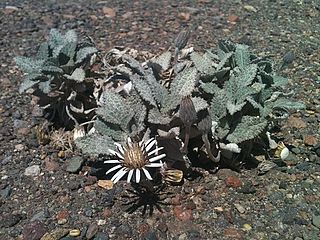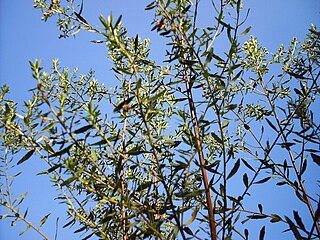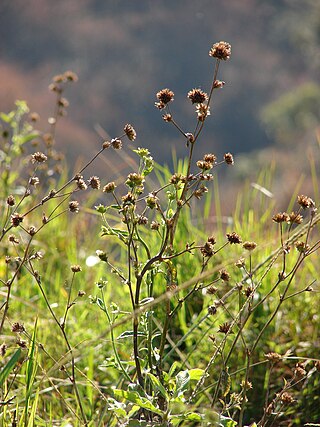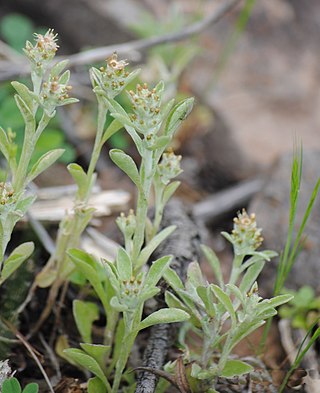
Acanthospermum hispidum is an annual plant in the family Asteraceae, which is native to Central and South America. This plant is cited as a weed in cotton culture in Brazil, and it is also used as a medicinal plant. It is also naturalized in many scattered places in Eurasia, Africa, and North America It is naturalized in Australia and is a declared weed in Western Australia.

Araujia is a small genus of perennial vines in the dogbane family first described as a genus in 1817. The group is native to South America.
- Araujia angustifolia(Hook. & Arn.) Steud. - Brazil, Paraguay, Uruguay, NE Argentina
- Araujia graveolens(Lindl.) Mast. - Brazil
- Araujia herzogii(Schltr.) Fontella & Goyder - Bolivia
- Araujia hortorumE.Fourn. - Brazil, Paraguay, Uruguay, NE Argentina
- Araujia megapotamica(Spreng.) G.Don - Brazil, Uruguay, NE Argentina
- Araujia plumosaSchltr. - Brazil, Paraguay, Bolivia, NW Argentina
- Araujia sericiferaBrot. - white bladderflower, cruel vine - Peru, Brazil; naturalized in parts of South Africa + United States
- Araujia stuckertiana(Kurtz ex Heger) Fontella & Goyder - Cordoba in Argentina
- Araujia subhastataE.Fourn. - Brazil
Oplismenopsis is a genus of South American plants in the grass family. The only known species is Oplismenopsis najada, native to southern Brazil, Uruguay, and northeastern Argentina.

Urmenetea is a genus of South American plants in the family Asteraceae.
Synedrellopsis is a genus of South American plants in the tribe Heliantheae within the family Asteraceae.

Baccharis dracunculifolia is a medical plant found in Brazil, Bolivia, Argentina, and Uruguay.

Bidens triplinervia is a Latin American species of flowering plants in the sunflower family. It is native to Mesoamerica and South America, from Chihuahua State in northern Mexico to Jujuy Province in northern Argentina.
Tweedia is a genus of flowering plants in the family Apocynaceae, first described as a genus in 1835. The genus is native to South America. An ornamental plant, Oxypetalum coeruleum, formerly included in this genus is commonly referred to as "tweedia".
- Tweedia andina(Phil.) G.H.Rua - Chile
- Tweedia aucaensisG.H. Rua - Argentina
- Tweedia australis(Malme) C. Ezcurra - Argentina
- Tweedia birostrata(Hook. & Arn.) Hook. & Arn. - Chile
- Tweedia brunonisHook. & Arn. - Argentina, Bolivia, Paraguay
- Tweedia echegarayi(Hieron.) Malme - Argentina
- Tweedia solanoides(Hook. & Arn.) Chittenden - Argentina, Brazil, Paraguay, Uruguay

Morrenia is a genus of flowering plants in the family Apocynaceae, first described as a genus in 1838. It is native to South America.
Melinia is a genus of plants in the family Apocynaceae, first described as a genus in 1835. It was initially given the name Brachylepis, but this turned out to be an illegitimate homonym, meaning that someone else had already used the name for a different plant. Melinia is native to South America.
- Melinia eichleri(E. Fourn.) K. Schum. - Brazil
- Melinia peruvianaSchltr. - Ayacucho in Peru
- Melinia volcanenseKrapov. & S. Cáceres - Jujuy Province in NW Argentina
Mitostigma is a genus of plants in the Apocynaceae first described as a genus in 1844. It contains only one accepted species, Mitostigma castillonii, native to Jujuy Province in northwestern Argentina
Chevreulia is a genus of plants in the family Asteraceae, described as a genus in 1817.
Cotula mexicana, also known as Mexican brassbuttons, is a plant species in the sunflower family. It is widespread in South America and also found in central Mexico and parts of the United States.

Elephantopus mollis, common names tobacco weed, and soft elephantsfoot, is a tropical species of flowering plant in the family Asteraceae.
Tagetes campanulata is a South American species of plants in the family Asteraceae. It is found in Argentina and Bolivia.
Tagetes pusilla, the lesser marigold, is a Latin American species of marigolds in the family Asteraceae. It is native Central America and western South America from Guatemala to northern Argentina.

Flaveria bidentis, the coastal plain yellowtops, is a South American plant species of Flaveria within the family Asteraceae. It is native to South America, and naturalized in many places.

Gamochaeta pensylvanica, the Pennsylvania cudweed or Pennsylvania everlasting, is a widespread species of flowering plant in the family Asteraceae. It is native to South America and introduced into Eurasia, Africa, Australia, and North America. The pensylvanica epithet is a misnomer, as the plant is not native to Pennsylvania and only marginally naturalized there.
Hymenoxys robusta is a South American species of flowering plant in the daisy family. It has been found primarily in Bolivia with a few populations in nearby Peru and Argentina.
Nélida María Bacigalupo (1924–2019) was an Argentine botanist, curator, and professor. She studied at the National University of La Plata, and in 1953, she received her doctorate in Natural Sciences at the same university. She served as an investigator at the Instituto de Botánica Darwinion, San Isidro, Buenos Aires. Bacigalupo did her botanical research in Paraguay and Argentina. She was a world authority on the family Rubiaceae. She was a member of the Argentine Botanical Society, and was the honorary vice-president of the 33rd Argentine Botany Conference in 2011.










